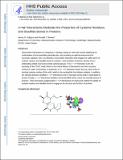n →π* Interactions Modulate the Properties of Cysteine Residues and Disulfide Bonds in Proteins
Author(s)
Kilgore, Henry R.; Raines, Ronald T
DownloadAccepted version (1.072Mb)
Terms of use
Metadata
Show full item recordAbstract
Noncovalent interactions are ubiquitous in biology, taking on roles that include stabilizing the conformation of and assembling biomolecules, and providing an optimal environment for enzymatic catalysis. Here, we describe a noncovalent interaction that engages the sulfur atoms of cysteine residues and disulfide bonds in proteins - their donation of electron density into an antibonding orbital of proximal amide carbonyl groups. This n→π∗ interaction tunes the reactivity of the CXXC motif, which is the critical feature of thioredoxin and other enzymes involved in redox homeostasis. In particular, an n→π∗ interaction lowers the pK a value of the N-terminal cysteine residue of the motif, which is the nucleophile that initiates catalysis. In addition, the interplay between disulfide n→π∗ interactions and C5 hydrogen bonds leads to hyperstable β-strands. Finally, n→π∗ interactions stabilize vicinal disulfide bonds, which are naturally diverse in function. These previously unappreciated n→π∗ interactions are strong and underlie the ability of cysteine residues and disulfide bonds to engage in the structure and function of proteins.
Date issued
2018-12Department
Massachusetts Institute of Technology. Department of ChemistryJournal
Journal of the American Chemical Society
Publisher
American Chemical Society (ACS)
Citation
Kilgore, Henry R. and Ronald T. Raines. “n →π* Interactions Modulate the Properties of Cysteine Residues and Disulfide Bonds in Proteins.” Journal of the American Chemical Society 140 (2018): 17606-17611 © 2018 The Author(s)
Version: Author's final manuscript
ISSN
0002-7863